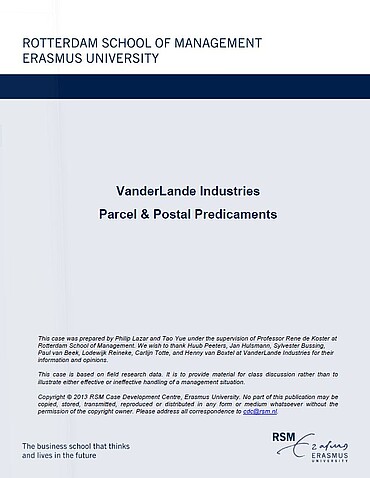description
Facing increasing pressure from new market entrants offering faster and cheaper solutions, Vanderlande Industries had to alter its customer-driven approach, towards a more efficient, modular and standardised approach. The Deutsche Post DHL projects were its first major success in making such a transition. Hoping to replicate that success on a much larger scale, Vanderlande was aware that it had to first address its infrastructure, organised entirely around customer-specific projects. Was there a way for Vanderlande to combine cost efficiency and customer attentiveness?
Citation Note
Based on field research; 9 pages.
Follow the 'handle' link to access the Case Study on RePub.
For EUR staff members: the Teaching Note is available on request, you can contact us at rsm.nl/cdc/contact/
For external users: follow the link to purchase the Case Study and the Teaching Note.
Objective
The main teaching objectives of this case are focused on product strategy and adjusting to changing market landscapes: 1. Understanding the differences between a product company and a project company. 2. Understanding the trade-offs between specialization and standardization, modularity and integration, innovation and cost-efficiency, responsiveness and economical value. 3. Exercising to manage these trade-offs in a complex situation. 4. Generating creative solutions to the dilemma(s).
usage
This case provides unique material for understanding the considerations involved in choosing an appropriate strategy for product offerings for different business and market contexts.
Abstract
VanderLande Industries (VI) was a strong global player in the distribution, parcel and postal (DPP) automation market, providing fully automated systems for parcel and posting sorting centers. VI’s product line had always remained strictly customer-centric, with every product built from scratch according to the customer’s wishes, but with increasing market pressure from new market entrants offering faster and lower-cost standardized solutions, the firm was seriously considering altering its market-responsive, service-focused and integrated product offerings towards a more efficient, modular and standardized output. This case describes the frameworks and knowledge related to the first set of large-scale, modular and standardized repeated projects that VI had offered. VI hoped to leverage its knowledge and experience accumulated from these projects and replicate the new approach in many future projects. However, VI’s infrastructure was not suitable for such a transition: the firm was entirely organized around customer-specific projects and employees were used to work for individual customers. Jan Hulsmann, managing director of VI’s DPP division, was struggling to find a way to re-organize the division so that it could be both cost efficient and customer attentive.
This case develops and highlights the considerations involved in choosing an appropriate strategy for product offerings. The case describes the difficulties in overcoming the trade-offs between service and efficiency, integration and modularity, and efficient and market-responsive supply chains, when designing or altering a product strategy. It delves into both the benefits as well as the downsides involved with different product strategy approaches, and attempts to make students think about what product strategy is most appropriate for what business and market context.
